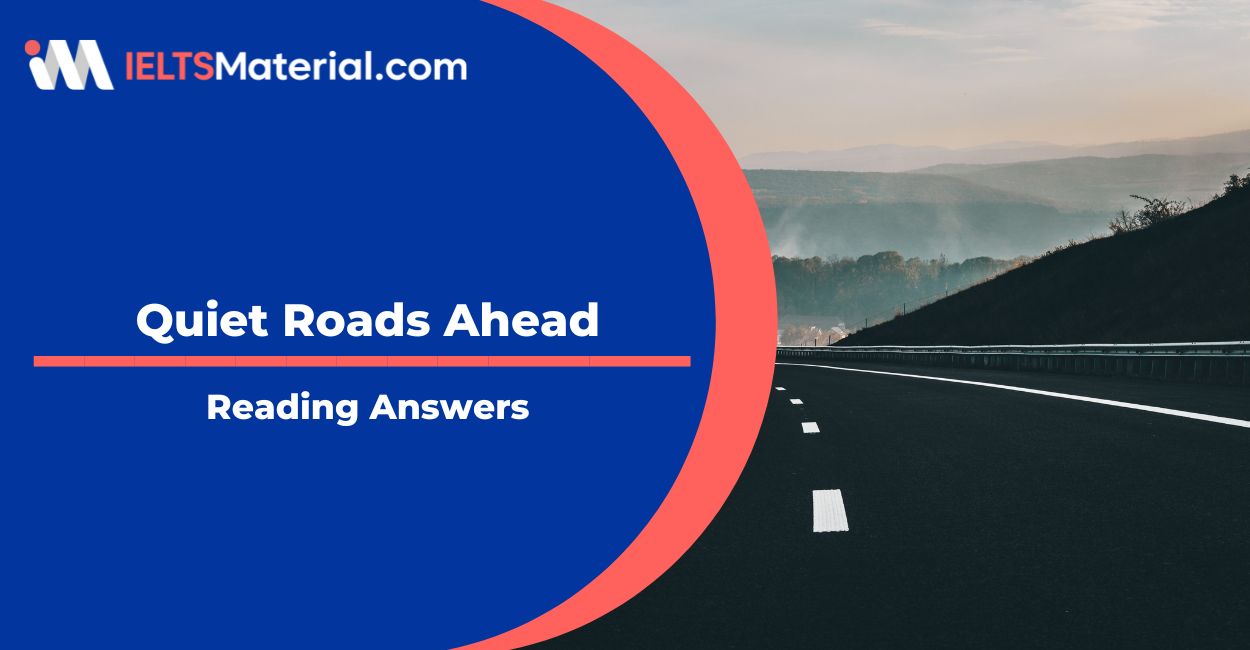Quiet Roads Ahead Reading Answers
3 min read
Updated On
-
Copy link
Table of Contents

Limited-Time Offer : Access a FREE 10-Day IELTS Study Plan!
This article contains the Quiet Roads Ahead reading answers.
Quiet Roads Ahead is a real Reading test passage that appeared in the IELTS.
With diligent practice, the Reading Module can be the top-scoring category for IELTS Aspirants. To score well, you must understand how to approach and answer the different question types in the Reading Module.
By solving and reviewing Sample Reading Questions from past IELTS papers, you can ensure that your Reading skills are up to the mark. Take the practice test Quiet Roads Ahead below and try more IELTS reading practice tests from IELTSMaterial.com.
Not sure how to answer IELTS Reading Matching Information questions? Check out the video below for the latest tips and strategies!
For more Table Completion Questions practice, take a look at IELTS Reading Table Completion Example 1!
Quiet Roads Ahead
You should spend about 20 minutes on Questions 1-13, which are based on the Reading Passage below. Find the practice test with the Quiet Roads Ahead PDF here.
Answers
| Question number | Answer | Keywords | Location of keywords |
|---|---|---|---|
| 27 | G | It emerges from the factory rolled, like a carpet, onto a drum 1.5 metres in diameter. On site, it is unrolled and stuck onto its foundation with bitumen. | Paragraph G;
Lines 1 – 2 |
| 28 | D | Hot asphalt, mixed with small stones, is spread into the mould by a rail mounted machine which flattens the asphalt mix with a roller. When it sets, the 10-millimetre-thick sheet has a surface smoother than anything that can be achieved by conventional methods. | Paragraph D;
Lines 4 – end |
| 29 | J | The success of Kuijpers’ design will depend on how much it eventually costs. | Paragraph J;
Line 3 |
| 30 | B | Houses become harder to sell where environmental noise is high, and people are not as efficient or productive at work. | Paragraph B;
Last line |
| 31 | I | On large highways, trucks tend to use the inside lane, so resonators here could be tuned to absorb sounds at around 600 hertz while those in other lanes could deal with higher frequency noise from cars. | Paragraph I;
Last line |
| 32 | C | He set out to tackle the three most important factors: surface texture, hardness and ability to absorb sound. | Paragraph C;
Last line |
| 33 | asphait | Hot asphalt, mixed with small stones, is spread into the mould by a railmounted machine which flattens the asphalt mix with a roller. | Paragraph D;
Line 4 |
| 34 | 9 | Those used in the top layer are just 4 or 5 millimetres across, while the ones below are approximately twice that size – about 9 millimetres | Paragraph F;
Line 2 |
| 35 | concrete | It consists of a sound-absorbing concrete base | Paragraph H;
Line 2 |
| 36 | E | Kuijpers says the surface can absorb any air that is passing through a tyre’s tread (the indentations or ridges on the surface of a tyre), damping oscillations that would otherwise create noise. | Paragraph F;
Line 3 |
| 37 | J | And in addition they make it easier for the water to drain away, which can make the road safer in wet weather. | Paragraph F;
Last line |
| 38 | G | These cavities act like Helmholtz resonators – when sound waves of specific frequencies enter the top of a flask, they set up resonances inside and the energy of the sound dissipates into the concrete as heat. | Paragraph H;
Line 3 |
| 39 | C | This flow will help flush out waste material and keep the pores in the outer layers clear. | Paragraph H;
Last line |
| 40 | A | Kuijpers can even control the sounds that his resonators absorb, simply by altering their dimensions. | Paragraph I;
Line 1 |
Check More IELTS Reading Answers
Also check :
Practice IELTS Reading based on question types

Start Preparing for IELTS: Get Your 10-Day Study Plan Today!
Recent Articles

Nehasri Ravishenbagam

Haniya Yashfeen

Haniya Yashfeen

Haniya Yashfeen




Post your Comments